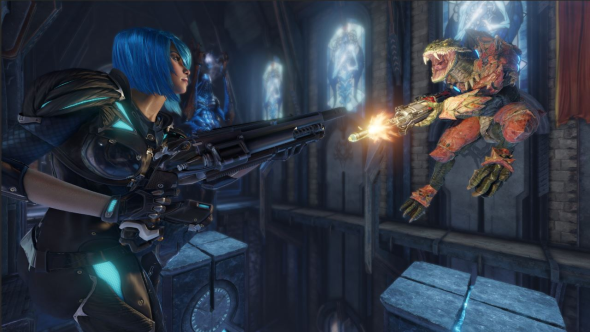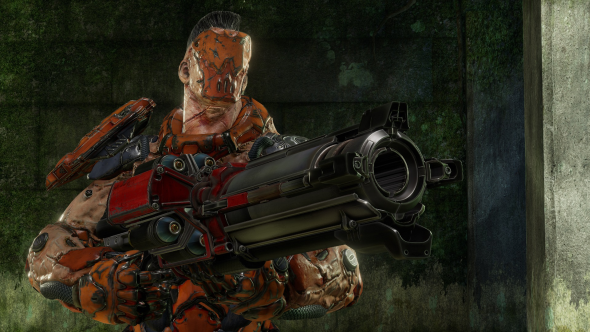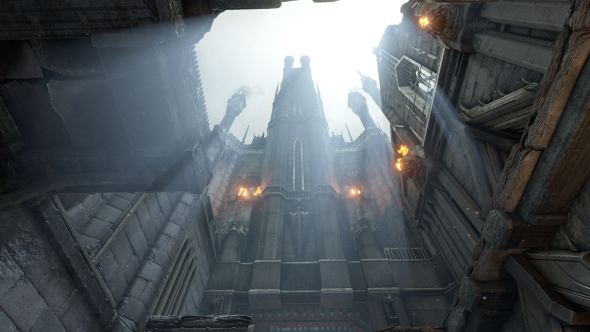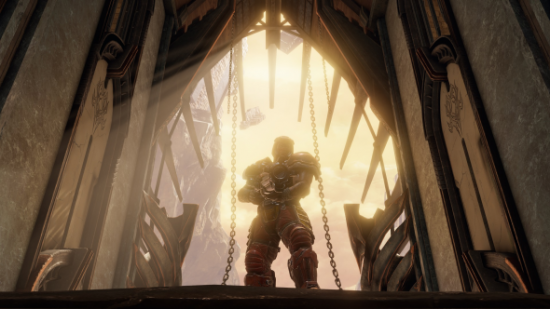Walk into the main hall at QuakeCon 2017 and the first thing you’ll see is the neon orange of the imposing Champions tournament stage. Turn 180 degrees, though, and you’ll notice a modest cosplay stand. On it sits a furry mask, unmistakably the fearsome face of the Shambler: all teeth, covered in yeti-like hair, and splattered with blood.
It’s a quiet reminder that Quake was once a single-player game as well as a competitive shooter – a gothic, medieval, and occasionally Lovecraftian journey across several dimensions that benefitted from the twisty, maze-like inclinations of John Romero and a crack team of fellow level designers.
Read more: the best PC games ever made.
But the series eventually dropped single-player for practical reasons. As the id biography Masters of Doom tells it, the team had independently developed a mish-mash of art assets, engine wizardry, and weapons – multiplayer maps were simply the best way to cobble them together. Which is why Quake III Arena’s plot can be covered in a single sentence: “The greatest warriors of all time fight for the amusement of a race called the Vadrigar in the Arena Eternal.” Vague, pithy, and pliant.

Quake has a place in the pantheon of single-player PC games – just as Doom was instrumental in inventing competitive shooting. Yet, over the course of two reboots, they’ve been sent down divergent paths: Doom is now id’s flagship campaign shooter, while Quake Champions represents the studio on the stages of esports events around the world.
“We’re very comfortable with that direction,” id and Quake Champions director Tim Willits tells us. “Doom has great multiplayer, make no mistake. But if you ask most videogame fans who have been around for a while what their best memory of Quake is, they are probably going to tell you, ‘Playing with dad, going to my buddy’s house at this LAN party, getting together at college to carry computers, hook stuff up, and run a cable across the hallway. We had these great deathmatches and we played all night’.
“That’s the memory that most people have of Quake. I mean, yeah, we’ve got Shamblers and the Strogg and stuff, and those are great. But people’s memories are multiplayer. That’s the direction we went with this. That’s the reason [Quake Champions] is multiplayer-only.”

It seems that Quake’s legacy is about its competitive community. But how did it wind up that way? Or to put the question differently: why was it called QuakeCon, and not DoomCon?
“This is controversial,” Willits answers. “Doom was hugely influential to our industry. But if you look at modern games today, and the path that they have taken, I will argue all day that Quake was actually more influential.”
He counts off the points of cultural significance on his fingers: The first proper 3D engine. True mod-making. Client-server architecture. A soundtrack from future Academy Award-winner Trent Reznor. The creation of clans, teams, and esports.

“It occurred at the birth of the real internet,” Willits says. “Most of these big websites, GameSpot and IGN, they can trace their roots all the way back to Quake-dedicated websites. There’s so many things that Quake did that has shaped today. That’s why it’s called QuakeCon.”
The future of the solo id shooter is assured: although there’s no campaign DLC on the table for Doom, the studio know exactly how extraordinary a return to single-player form that game was. As soon as they’ve made progress along that path, they’ll let us all know.
But Quake, as Willits sees it, helped form the online world we all live and play in. For id to make Quake Champions – and to dedicate it wholly to multiplayer – is to recognise that fact and honour its history in the best way they know how.
